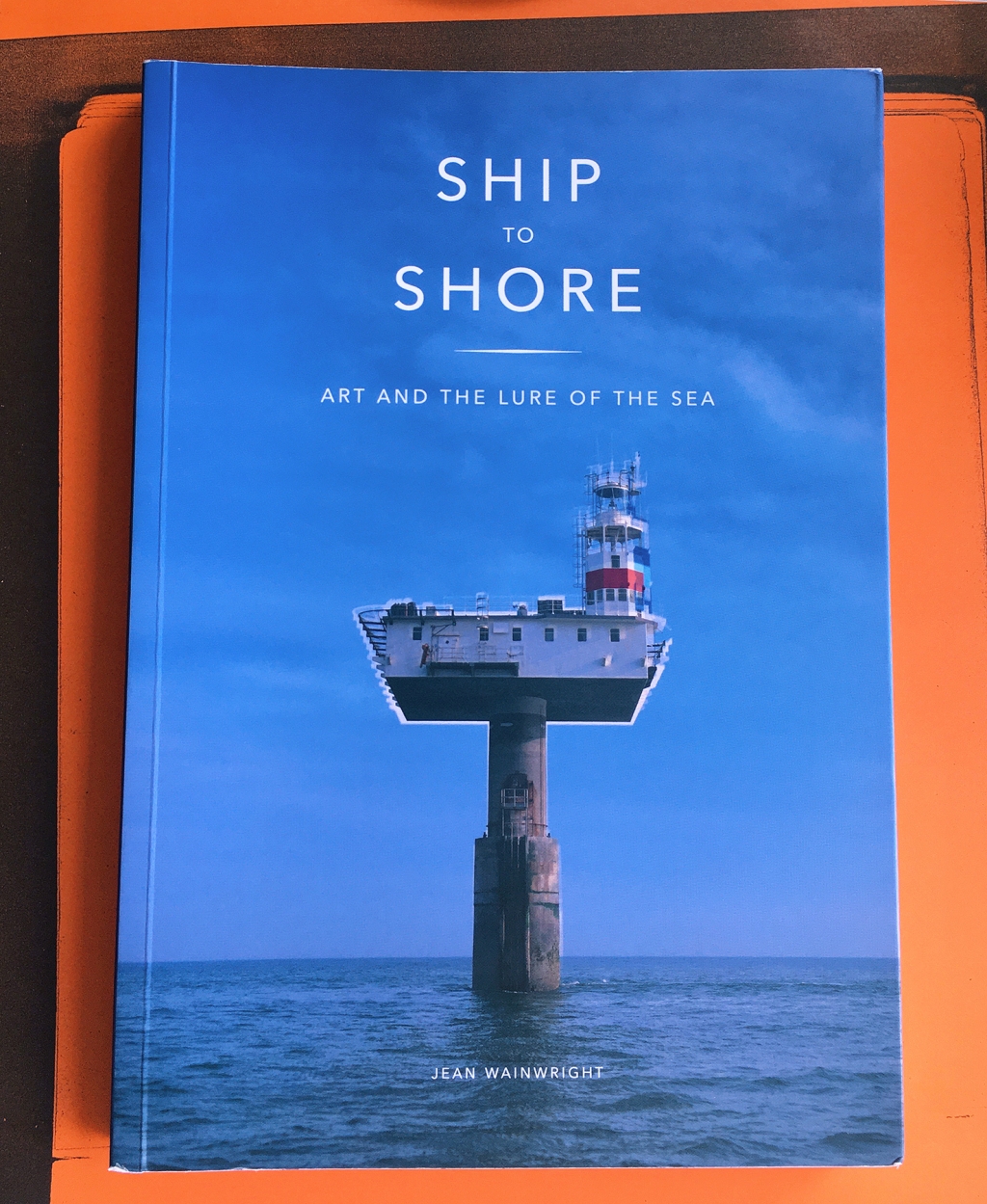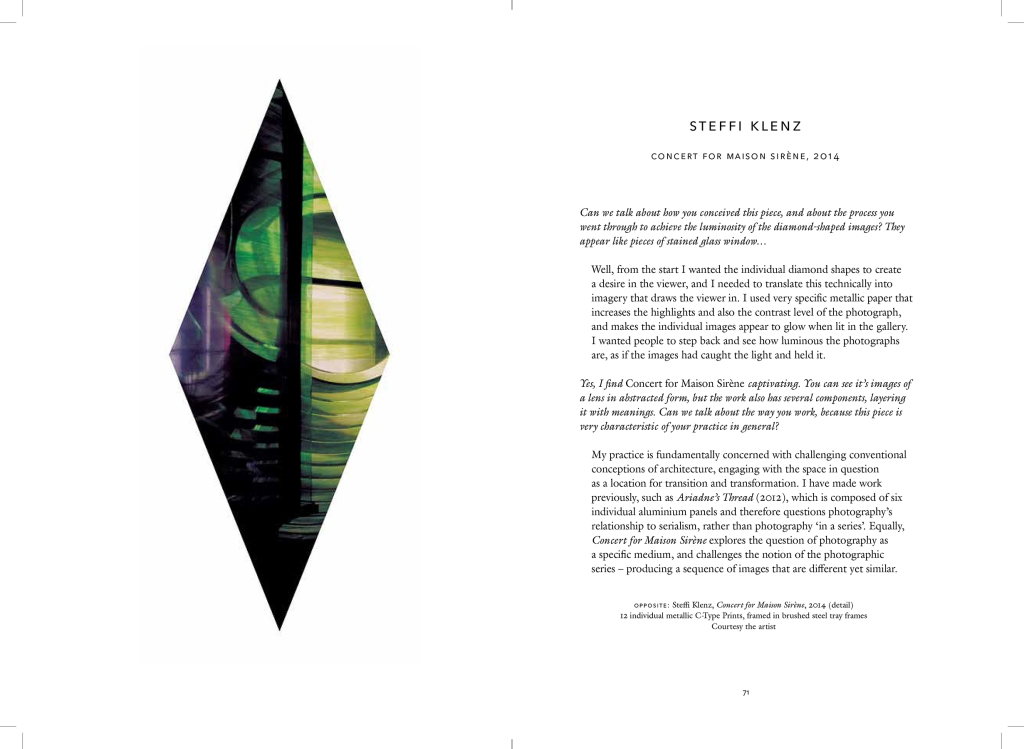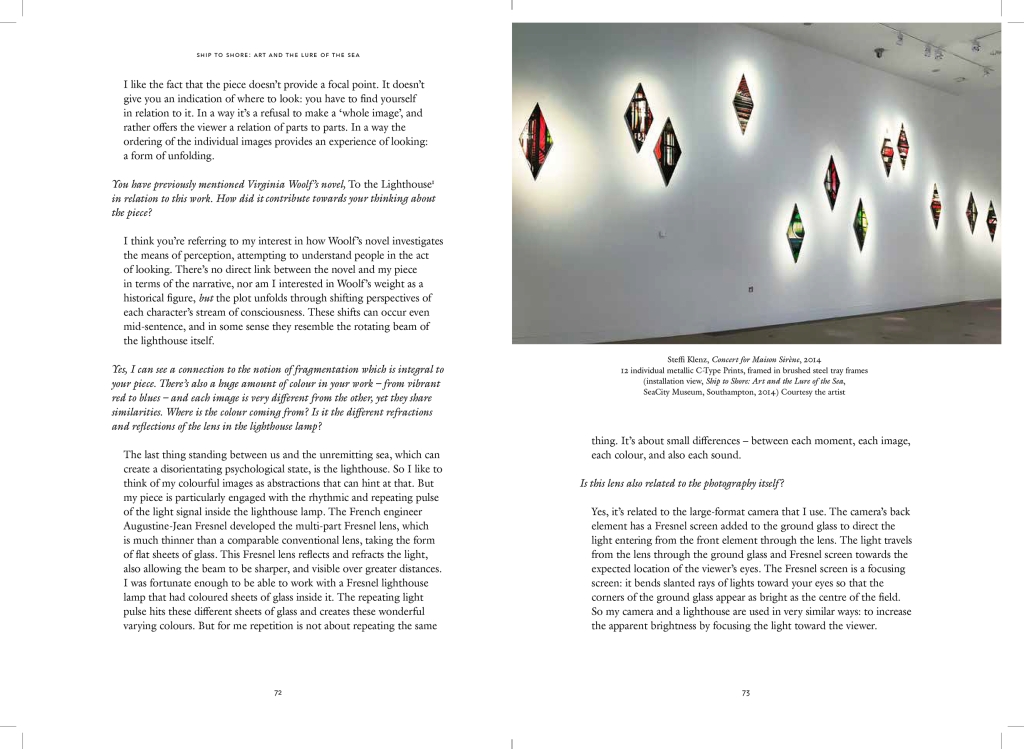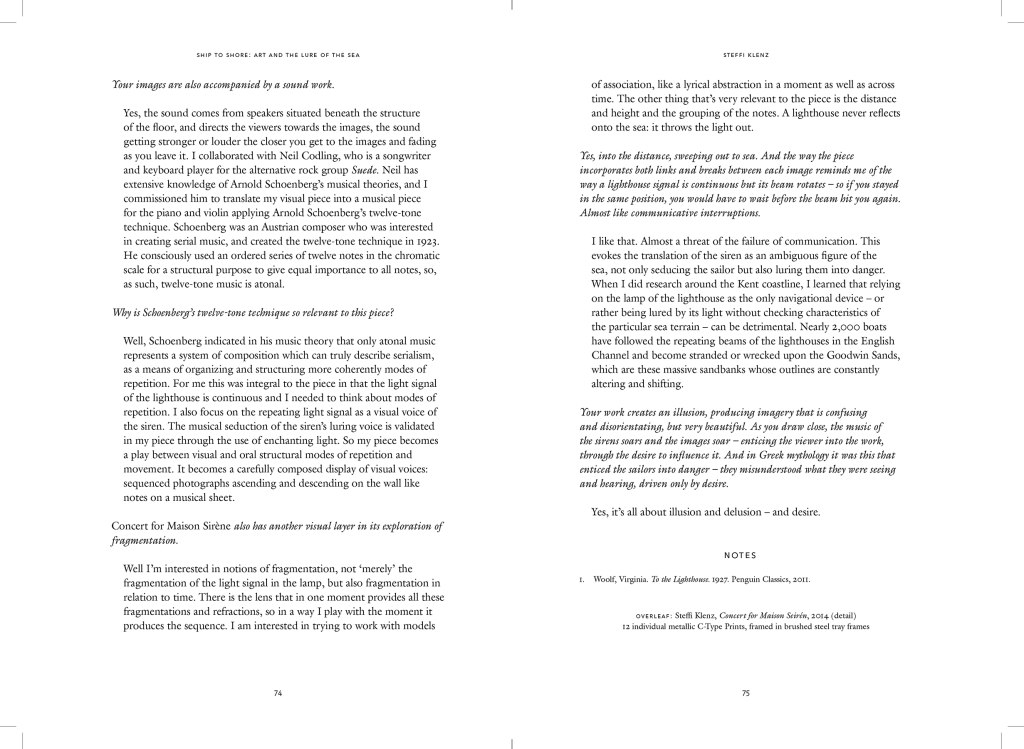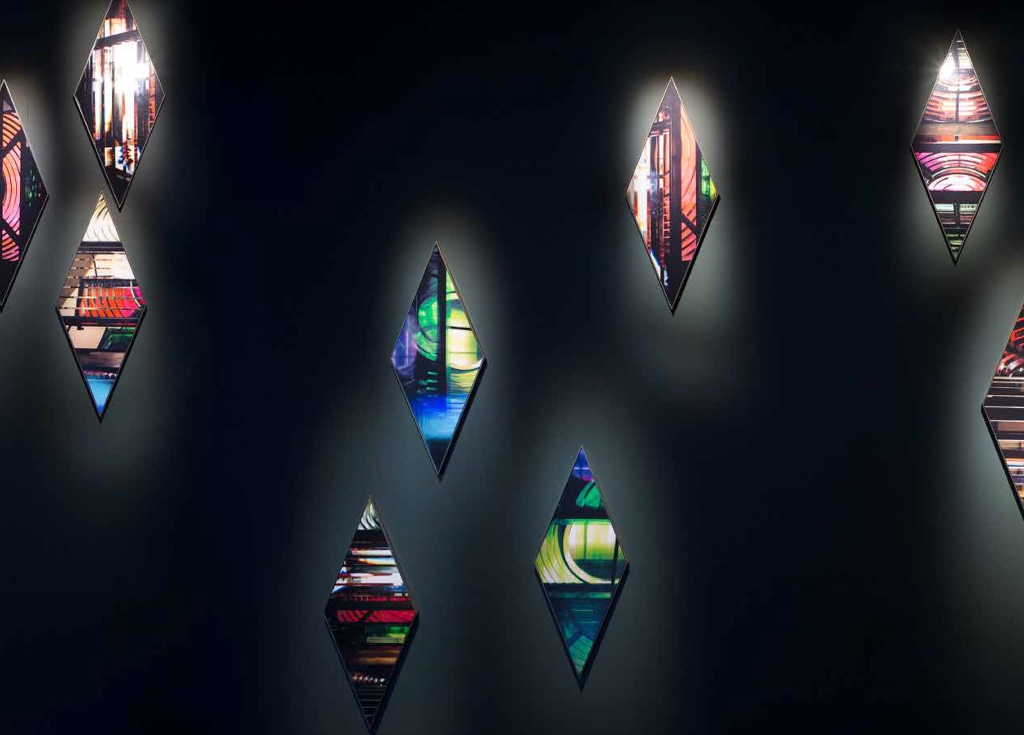Ship to Shore
JEAN: Can we talk about how you conceived this piece, and about the process you went through to achieve the luminosity of the diamond-shaped images? They appear pieces of stained glass window…
STEFFI: Well, from the start I wanted the individual diamonds to create a desire in the viewer, and I needed to translate this technically into imagery that draws you in.I used very specific metallic paper that increases the highlights and also the contrast level of the photograph and makes the individual images appear to glow when lit in the gallery. I wanted that you step back and see how luminous the photographs are, as if the images had caught the light and held it.
JEAN: I find Concert for Maison Seirén captivating. You can see it’s images of a lens in abstracted form, but the work has also several components, layering it with meanings. Can we talk about the way you work, because this piece is very characteristic of your practice in general?
STEFFI: My practice is fundamentally concerned with challenging conventional conceptions of architecture, engaging with the space in question as a location for transition and transformation. I have made work previously, such as Ariadne’s Thread (2012), which is composed of six individual aluminium panels and questions photography’s relationship to serialism rather than photography ‘in series’. Equally, Concert for Maison Seirén explores the question of photography as a specific medium, and challenges the notion of the photographic series - producing a sequence of images that are different yet similar. I like the fact that the piece does not provide a focal point. It doesn’t give you an indication of where to look: you have to find yourself in relation to it. In a way it is a refusal to make a ‘whole image’ and rather offers the viewer a relation of parts to parts. In a way the ordering of the individual images provides an experience of looking: a form of unfolding.
JEAN: You have previously mentioned Virginia Woolf’s novel To the Lighthouse in relation to this work. How did it contribute towards your thinking about the piece?
STEFFI: I think you are referring to my interest in how Woolf’s novel investigates the means of perception, attempting to understand people in the act of looking. There is no direct link between the novel and my piece in terms of the narrative nor am I interested in Woolf’s weight as a historical figure, but the plot unfolds through shifting perspectives of each character's stream of consciousness. These shifts can occur even mid-sentence, and in some sense they resemble the rotating beam of the lighthouse itself.
JEAN: Yes, II can see a connection to the notion of fragmentation which is integral to your piece. There’s also a huge amount of colour in your work – from vibrant to blues - and each image is very different from the other, yet they share similarities - and yet similar. Where are the colours coming from? Is it the different refractions and reflections of the lens in the lighthouse lamp?
STEFFI: The last thing standing between us and the unremitting sea, which can create a disorientating psychological state, is the lighthouse. So I like to think of my colourful images as abstractions that can hint at that. But my piece is particularly interested in the rhythmic and repeating pulse of the light signal inside the lighthouse lamp. The French engineer Augustine-Jean Fresnel developed the multi-part Fresnel lens, which is much thinner than a comparable conventional lens, taking the form of flat sheets of glass. This Fresnel lens reflects and refracts the light, also allowing the beam to be sharper, and to be visible over greater distances.
I was fortunate enough to be able to work with a lighthouse lamp that had coloured sheets of glass inside it. The repeating light pulse hits these different sheets of glass and creates these wonderful varying colours. But for me repetition is not about repeating the same thing. It is about small differences - between each moment, each image, each colour and also each sound.
JEAN: Is this lens also related to photography itself?
STEFFI: Yes, it is related to the large-format camera that I use. The camera’s back element has a Fresnel screen added to ground glass to direct the light entering from the front element through the lens. The light travels from the lens through the ground glass and Fresnel screen towards the expected location of the viewer’s eyes. The Fresnel screen is a focusing screen: it bends slanted rays of lights toward your eyes so that the corners of the ground glass appear as bright as the centre of the field. So my camera and a lighthouse are used in similar ways: to increase the apparent brightness by focusing the light toward the viewer.
JEAN: Your images are also accompanied by a sound work.
STEFFI: Yes, the sound comes from speakers situated beneath the structure of the floor, and directs the viewers towards the images, the sound getting stronger or louder the closer you get to the images and fading as you leave it.
I collaborated with Neil Codling, who is a songwriter and keyboard player for the alternative rock group Suede. Neil has extensive knowledge of Arnold Schoenberg’s musical theories, and I commissioned him to translate my visual piece into a musical piece for the piano and violin applying Arnold Schoenberg's twelve-tone technique. Schoenberg was an Austrian composer who was interested in creating serial music, and created the twelve-tone technique in 1923. He consciously used an ordered series of twelve notes in the chromatic scale for a structural purpose to give equal importance to all notes, so, as such, twelve-tone music is atonal.
JEAN: Why is Schoenberg twelve-tone technique so relevant to this piece?
STEFFI: Well, Schoenberg indicated in his music theory that only atonal music represents a system of composition which can truly describe serialism, as a means of organizing and structuring more coherently modes of repetition. For me this was integral to the piece in that the light signal of the lighthouse is continuous and I needed to think about modes of repetition. I also focus on the repeating light signal as a visual voice of the siren. The musical seduction of the siren’s luring voice is validated in my piece through the use of enchanting light. So my piece becomes a play between visual and oral structural modes of repetition and movement. It becomes a carefully composed display of visual voices: sequenced photographs ascending and descending on the wall like notes on a musical sheet.
JEAN: Concert for Maison Seirén also has another visual layer in its exploration of fragmentation.
STEFFI: Well, I’m interested in notions of fragmentation, not just ‘merely’ the fragmentation of the light signal in the lamp, but also fragmentation in relation to time. There is the lens that in one moment provides all these fragmentations and refractions, so in a way I play with the moment it produces the sequence. I am interested in trying to work with models of association, like a lyrical abstraction in a moment as well as across time. The other thing that’s very relevant to the piece is the distance and height and the grouping of the notes. A lighthouse never reflects onto the sea: it throws the light out.
JEAN: Yes, into the distance, sweeping out to sea. And the way the piece incorporates both links and breaks between each image reminds me of the way a lighthouse signal is continuous but its beam rotates – so if you stayed in the same position, you would have to wait before the beam hit you again.
Almost like communicative interruptions.
STEFFI: I like that. Almost a threat of the failure of communication. This evokes the translation of the siren as an ambiguous figure of the sea, not only seducing the sailor but also luring them into danger. When I did research around the Kent coastline I learned that relying on the lamp of the lighthouse as the only navigational devise - or rather being lured by its light without checking characteristics of the particular sea terrain can be detrimental. Nearly 2000 boats followed the repeating beam of the lamp of the lighthouses across the English Chanel and become stranded or wrecked upon the Goodwin Sands, which are these massive sandbanks whose outlines are constantly altering and shifting.
JEAN: Your work creates an illusion, producing imagery that is confusing and disorientating, but very beautiful. As you draw close, the music of the siren soars and your images soar – enticing the viewer into the work, through the desire to influence it. And in Greek mythology it was this that enticed the sailors into danger - they misunderstood what they were seeing and hearing, driven only by desire.
STEFFI: Yes, it is all about illusion and delusion – and desire.
Jean Wainwright is an art historian, critic and curator living in London. Her areas of expertise are in contemporary art and photography and she regularly contributes to Audio Arts, The Art Newspaper, Art World, The Guardian and Art Review.
(This interview between Jean Wainwright and Steffi Klenz was firstly published in the book Ship to Shore: Art and the Lure of the Sea, published in the UK by Cornerhouse Publications in 2018)
